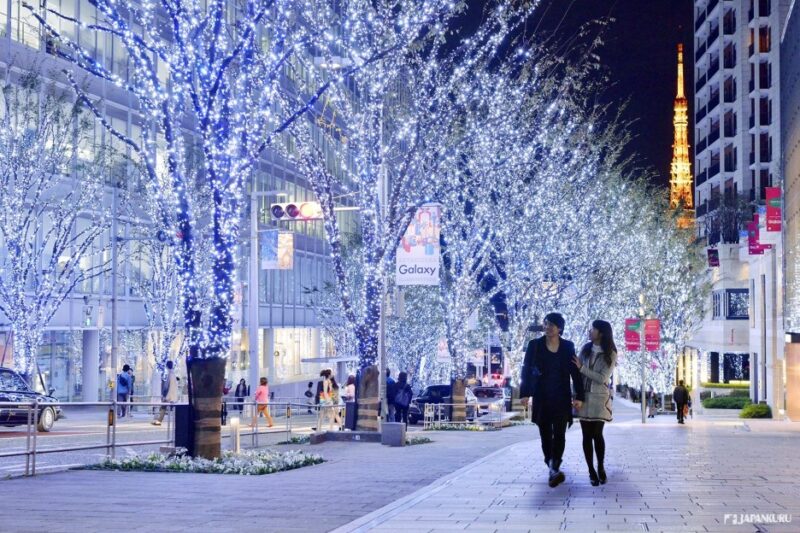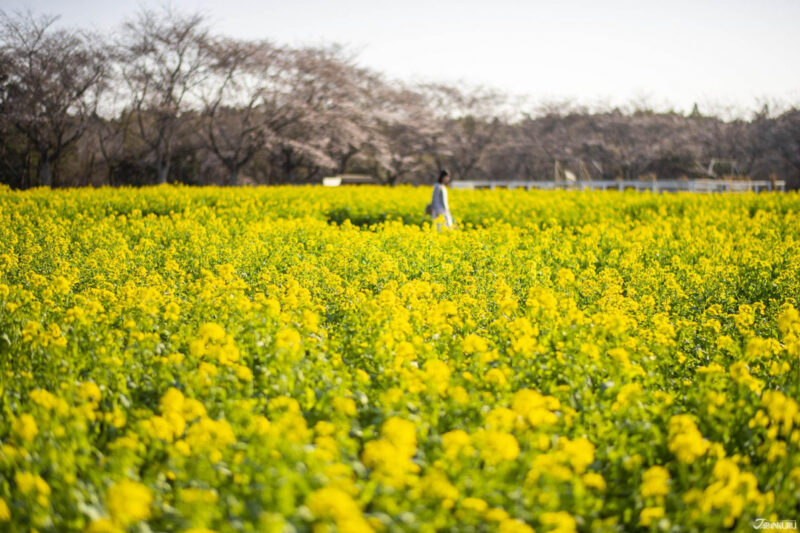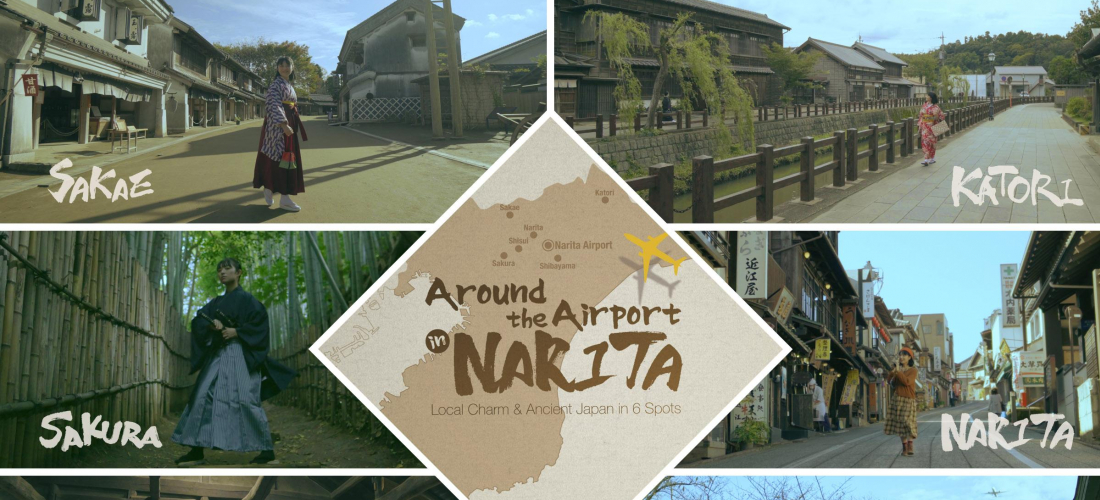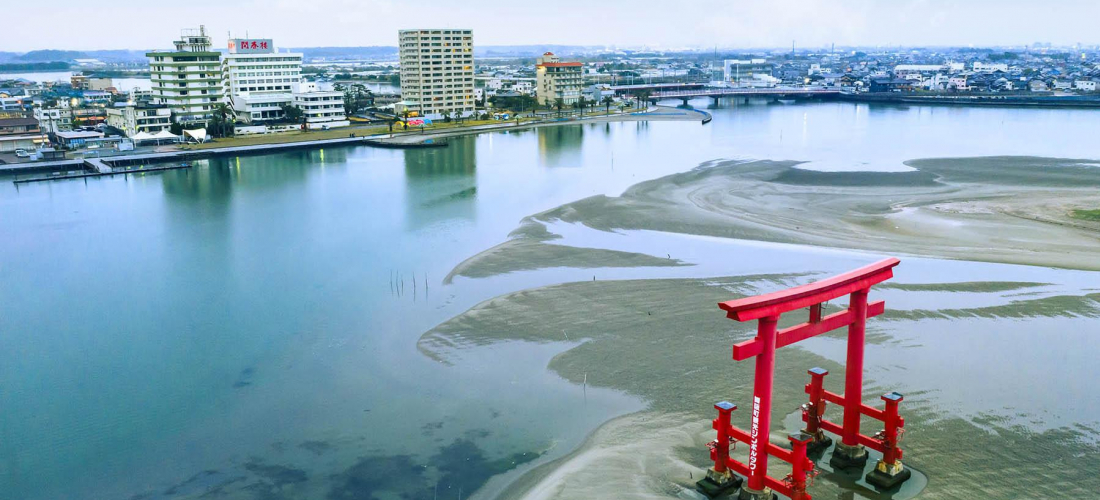
CONTENTS
Hamamatsu City, Shizuoka
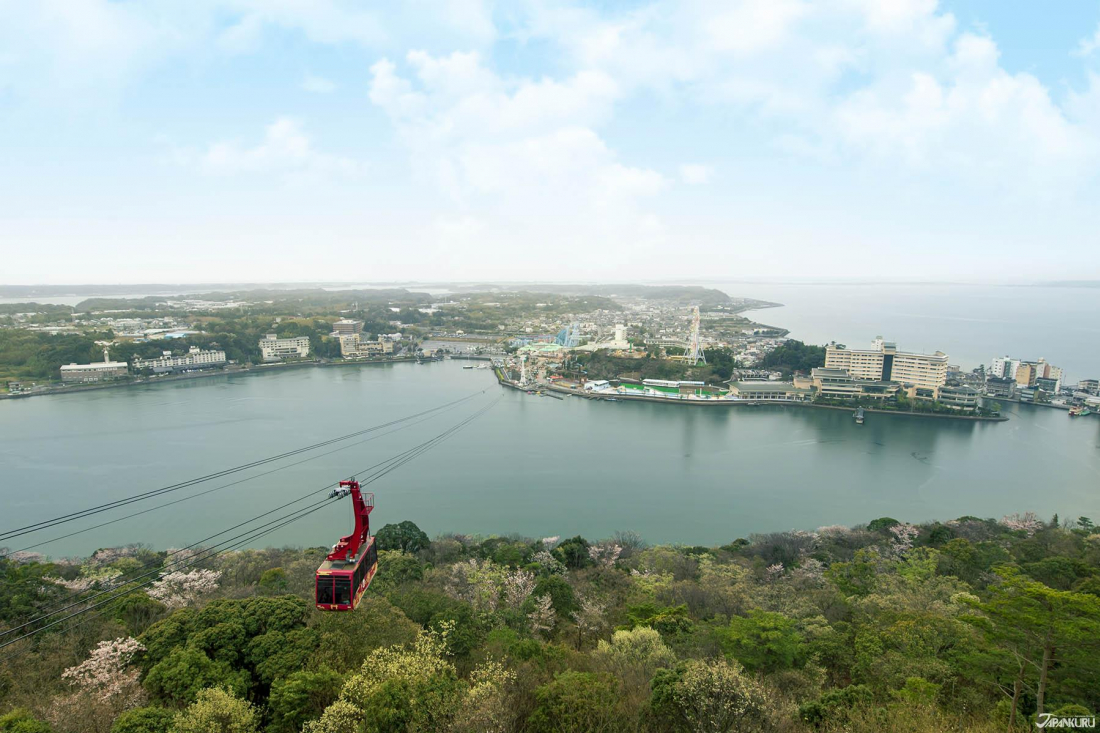
If you’re in the midst of planning for a trip to Japan, you might have come across the name Shizuoka by now. But Shizuoka Prefecture isn’t only the home of Mount Fuji! Shizuoka’s city of Hamamatsu, a stop on the shinkansen line that connects Tokyo, Nagoya, Osaka, and Kyoto, is a unique destination: part industrial center and part lakeside resort, on the shores of Lake Hamanako (浜名湖, also called Lake Hamana). Home to Honda vehicles and Yamaha pianos, but also known for some of the best eel in Japan, Hamamatsu City is an off-the-beaten-path spot that’s shockingly accessible. At first glance it might be hard to see, but if luxe onsen (温泉, hot springs), high-quality tea, gourmet seafood (eel and pufferfish) and gyoza, and botanical gardens full of flowers sound good to you, you might just want to start planning your trip to Hamamatsu.
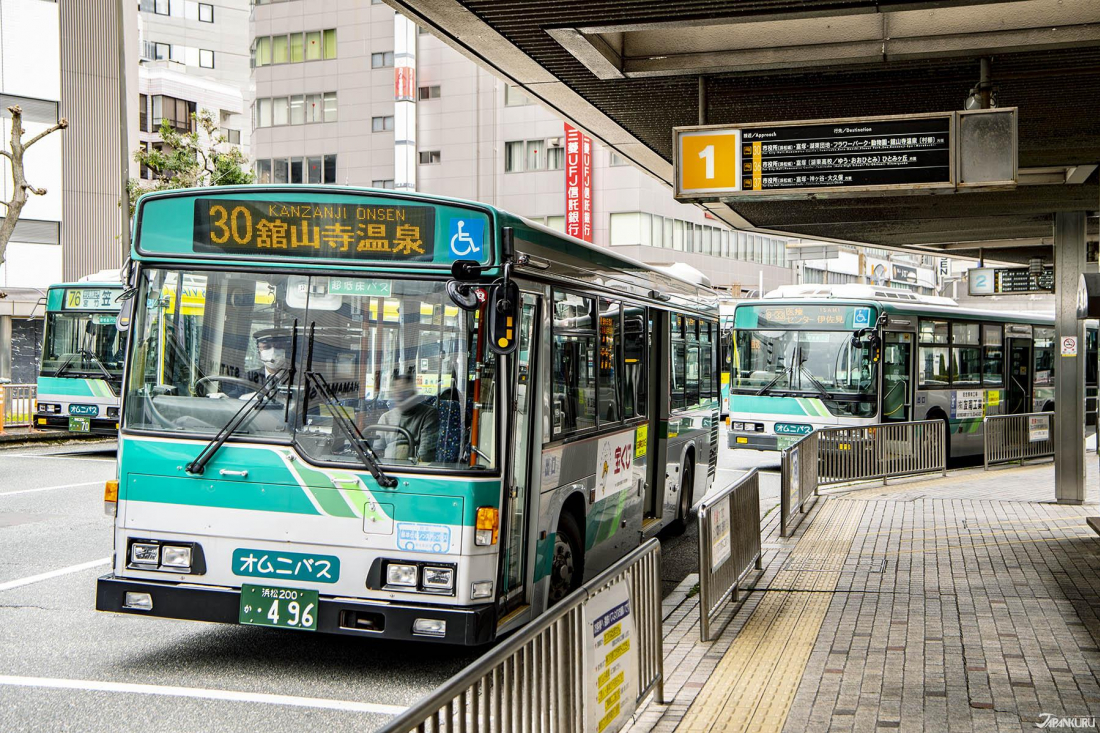
Thanks to Hamamatsu Station’s place on the Tokaido Shinkansen (bullet train) line, it’s one of the most easily accessible cities in Japan, just a few stops away from Tokyo, Nagoya, Osaka, or Kyoto. Or if it’s the first stop on your Japan travel itinerary, you can take the bus directly there from Nagoya Chubu International Airport. Once you arrive in the city, a variety of local rail lines and buses can get you from place to place. To get the most out of the city, it might be worth looking into the Hamanako Rail Pass, which is a 2- or 3-day pass that gives you unlimited rides on the Entetsu Railway, Entetsu Buses, Tenryu Hamanako Railroad, and Hamanako Cruises, plus a one-way ride on the airport bus.
Lake Hamanako
Lake Hamanako (浜名湖): Cable Cars and Salty Waters

Once a true freshwater lake, the small piece of land that separated Lake Hamanako from the Pacific Ocean was breached way back in 1498, when an earthquake shook the area and turned it into the brackish lagoon we see today. The lake makes Hamamatsu’s aquatic environments just the right place for the unagi (うなぎ, eels) and fugu (ふぐ, pufferfish) the area is now famous for! And these days a handful of sightseeing attractions can be found around the water’s edge, like the Hamanako Pal Pal amusement park, Kanzanji Onsen, and the Hamanako Orgel Museum (dedicated to music boxes).
The route to the orgel museum requires a trip on a cable car, and whether you’re interested in music boxes or not, a ride on the cable cars of Kanzanji Ropeway is a must. For four minutes you glide right over and across the calm waters of Lake Hamanako, traveling 723 meters (almost half a mile) from one shore to the mountainous area opposite. Once you arrive, you can look out at the view for as long as you like from the Okusayama observation deck, before taking one last trip on the only cable car in Japan that travels over a lake.
Kanzanji Ropeway (Okusayama Observation Deck)
Hours: 9:00 – 17:30
Roundtrip Tickets: Children 420 yen / Adults 840 yen
Official Website (en)
Tenryu Hamanako Railroad (天竜浜名湖鉄道): Historic Stations & Fields of Flowers
Nicknamed the Tenhama Line, this local railroad is the polar opposite of the shinkansen that can take you to Hamamatsu Station. Winding its way through western Shizuoka, the ~70km (42 mile) railway is full of retro charm and local history. About a dozen of the Tenhama stations are registered as national tangible cultural properties, thanks to well-maintained historical buildings and connections to railroad history, and our ride on the train line felt a little like traveling back in time. A must-see for railway fans.

Kiga Station is one of the many tangible cultural properties, full of Showa era charm. But while that might appeal to retro train enthusiasts, we heard that motorcycle riders instead flock to the ramen shop inside the station building!
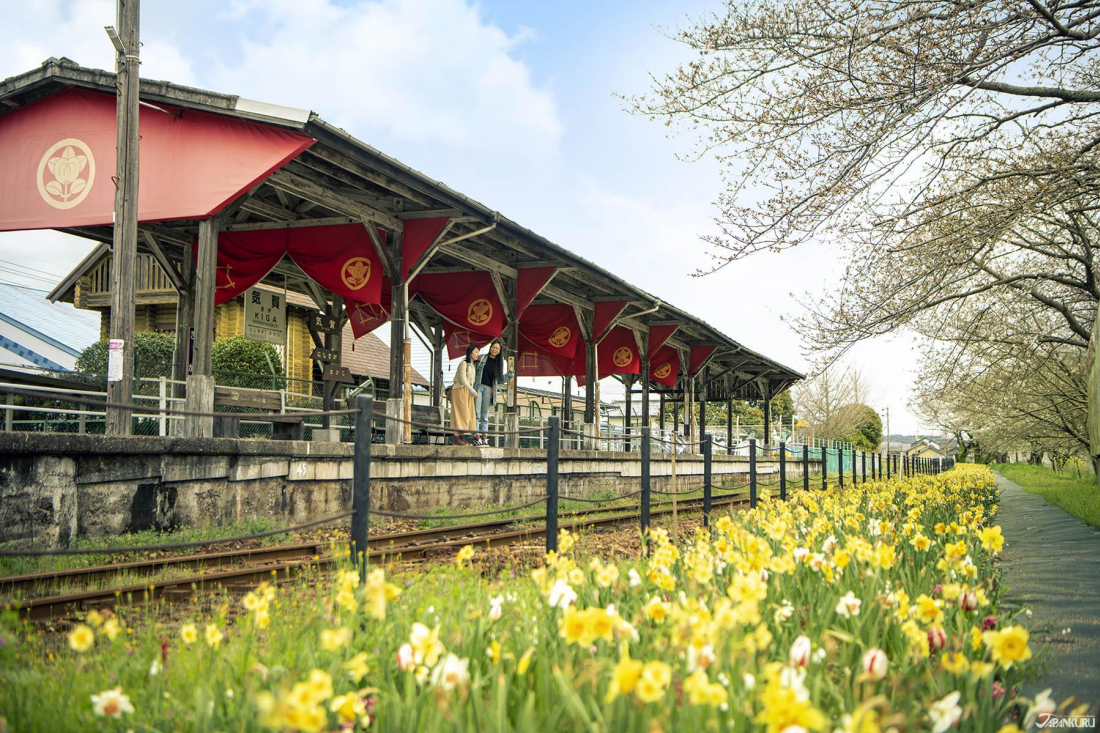
Among many things, Hamamatsu is a city of flowers, and the railroad has made moves to plant colorful blossoms and add a little extra cheer to a number of stations. The daffodils in the foreground and the retro wooden roof in the back make the Kiga Station platform look like a movie set.

We appreciated the relaxed pace of the route through Japan’s countryside and around Lake Hamanako. After hearing about all the history at each station (and a station decorated by Marimekko!), next time our itinerary will definitely include a few more stops.

Tenryu Hamanako Railroad
Kiga Station: Hosoecho Kiga, Kita Ward, Hamamatsu, Shizuoka
Official Website (en)
Nukumori no Mori (ぬくもりの森): Fairytale Architecture & Owls
A scene straight out of Studio Ghibli? A village stolen from rural Europe? A new Disney park? No, this is Nukumori no Mori, which loosely translates to “Cozy Forest.”
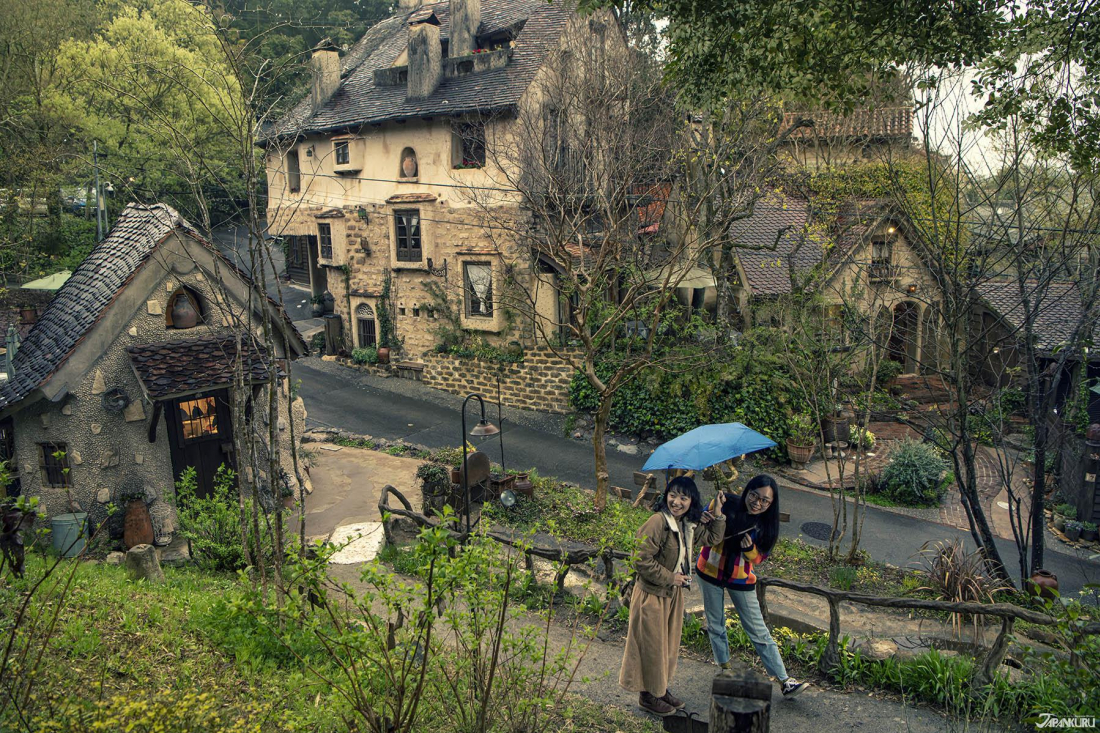
The complex of buildings was created by architect Shigeyoshi Sasaki, and it all began in 1983 as just a single house, before it became this little village open to the public. No longer a private home, these days a quaint collection of cottages are nestled in the greenery next to the main house, containing a variety of little shops mostly selling trinkets and all surrounded by trees. Very Ghibli-esque, unofficially.
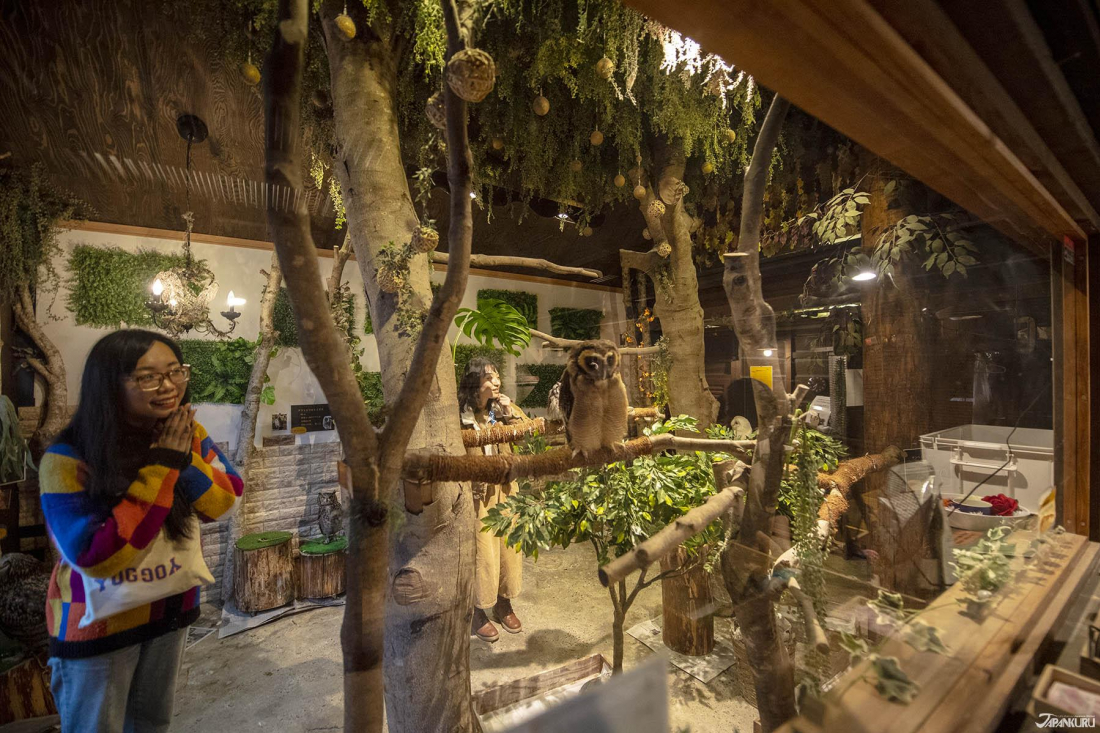
The architecture Sasaki designed and built throughout Nukumori no Mori clearly draws inspiration from all over the world, and you never know just what you’ll find behind the next door you open. Sometimes… it’s owls! For 1,000 yen, you can enter one of the little cottages to see owls of all kinds up close, and even pet them oh-so-gently.
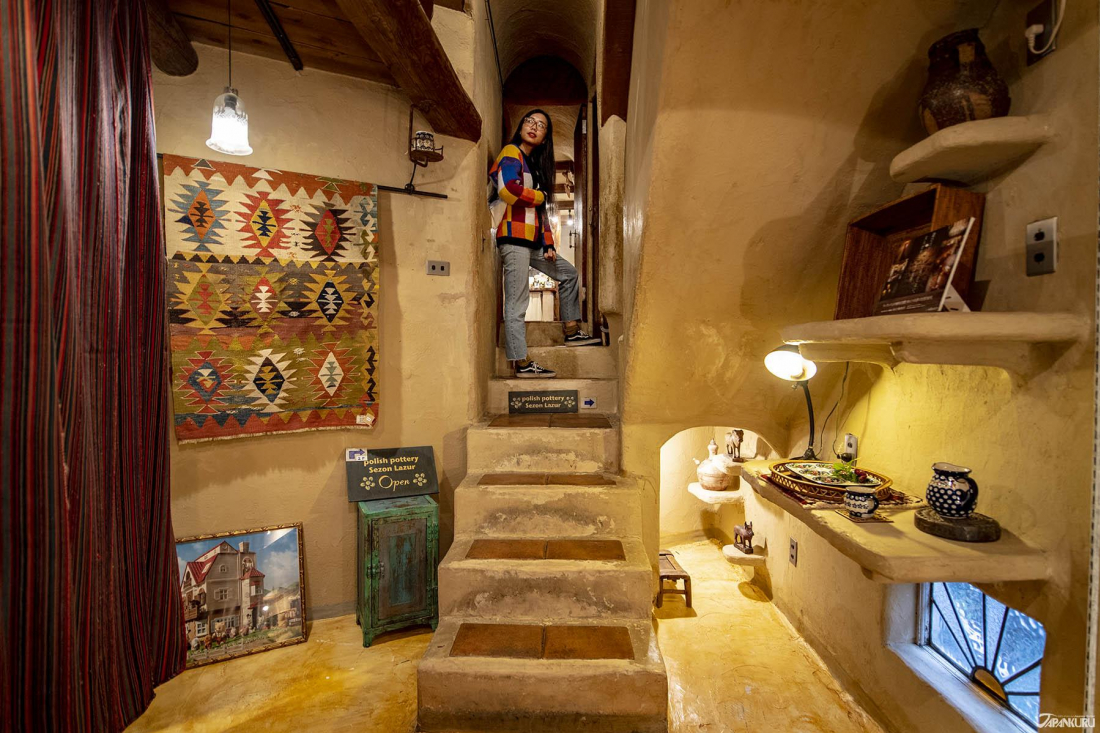
Even apart from the little houses, inside the main house and an addition built around a little courtyard you’ll find a cafe, a little patisserie, and shops selling things like aroma oils and pottery. For many visitors, however, the shopping is just an extra treat – the main objective here is photography! This particular staircase is a popular photo spot because many people think it looks like something out of Howl’s Moving Castle.
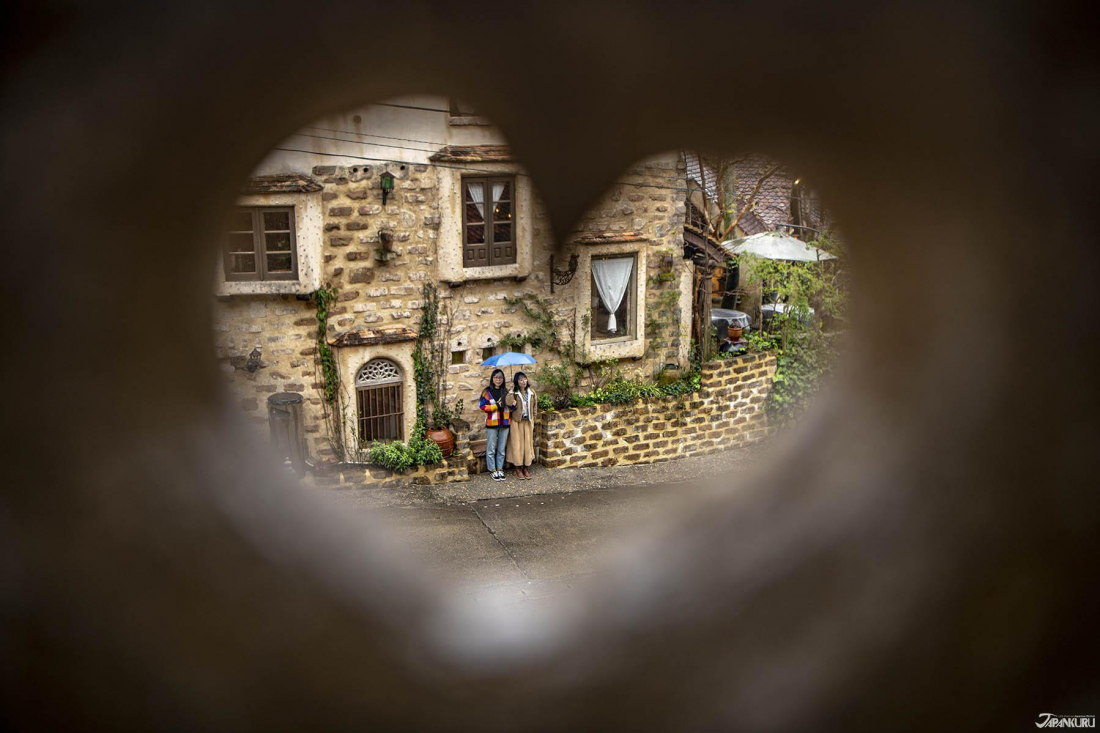
One of the most popular photo spots in the little village is behind this little heart.

We couldn’t resist taking our own picture framed by the railing! ♡
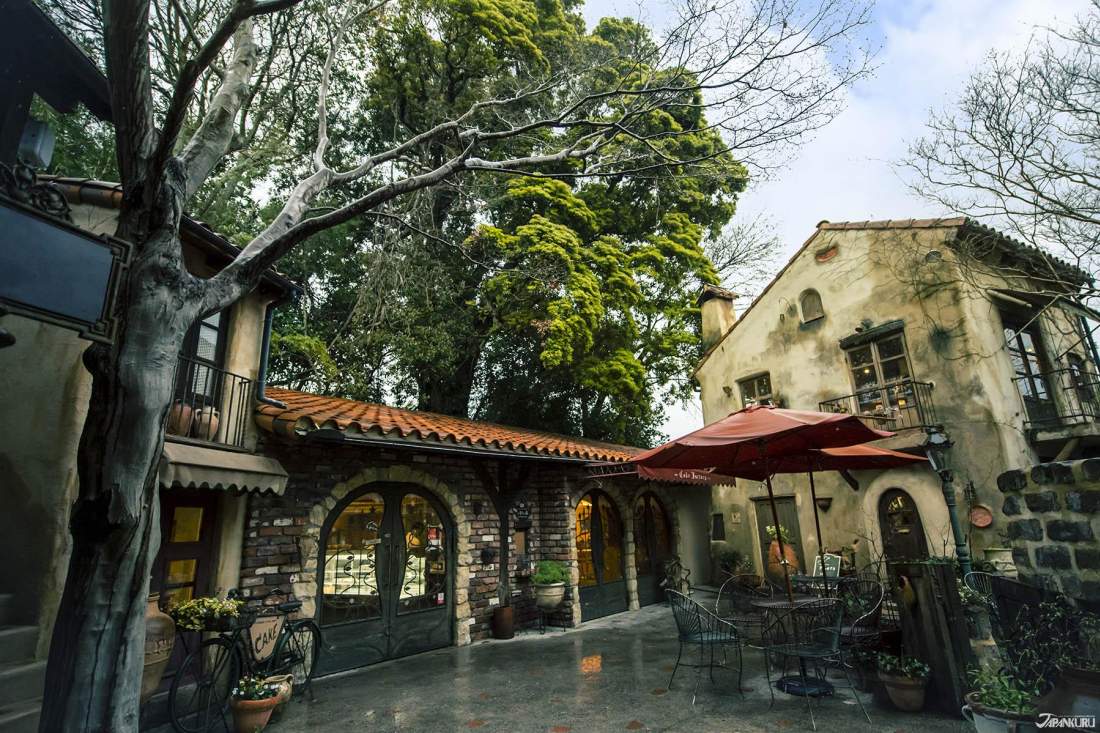
The architecture inside the main house is playful and surprising in all the best ways. You can slip your way through caves and under trees, without ever going outside! Get yourself a little lost and you’ll definitely get yourself some great pictures.

One last photo before you leave – don’t forget to recreate the classic bus scene from Totoro!
Nukumori no Mori (ぬくもりの森)
2949 Waji-cho, Nishi-ku, Hamamatsu, Shizuoka
Hours vary, find details here.
Admission: 400 yen
Official Website (en) / (jp)
Strawberry Picking

There’s nothing more satisfying than enjoying the fruits of your labor, and it doesn’t get any more literal than this. Hamamatsu is famous for delicious strawberries, and every spring the greenhouses open to customers who pay a flat fee to pick and eat as many strawberries they like! Visitors with a sweet tooth can even dip their strawberries into sweetened condensed milk before digging in.
Agurisu Hamanako Strawberry Picking
2014-1 Hiramatsucho, Nishi Ward, Hamamatsu, Shizuoka
Admission:
・ Mid-December ~ January 6th: 1800
・ January 7th ~ March 31st: 1600
・ April 1st ~ early May: 1200
Official Website (jp)
Bentenjima (弁天島): Benten Island & Its Shrine Gate

Part of the appeal of Hamamatsu’s Lake Hamanako is its history, transforming from freshwater lake to seaside lagoon 500 years ago as a result of a dramatic seismic event. In more recent years, one landmark has boosted Lake Hamanako’s popularity among sightseers searching for beautiful landscapes.
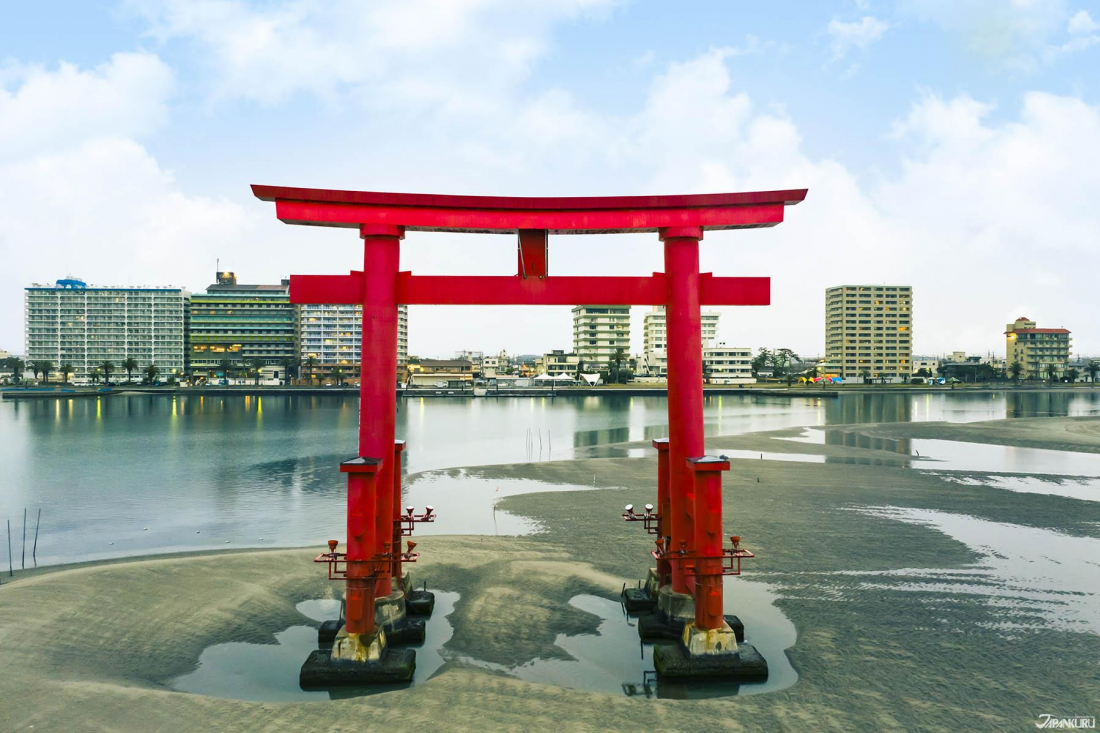
If you’ve spent time in Japan before, you might be wondering why there’s a “torii” (鳥居, shrine gate) in the middle of the sand and water, and where the shrine itself is. Unlike the similar torii of Itsukushima Shrine in Hiroshima, there is no shrine attached to the Bentenjima Torii! This 18-foot-high shrine gate has stood on its own since 1968, elevated on a sand bar off of Bentenjima (or Benten Island) in Lake Hamanako.

Travelers can take a boat over to see the torii up close between April and August, or just enjoy the view from the water’s edge – the seaside park is great for a relaxing stroll, and people make a point of watching the sun set behind the gate. To make a day of it, try digging for clams as well!
Benten Island (弁天島)
Maisakacho Bentenjima, Nishi Ward, Hamamatsu, Shizuoka
Boat Tickets: 1,000 yen
Official Website (jp)
Hoshino Resorts KAI Enshu: Green Tea & Hot Springs

After a day out on the lake, there’s nowhere better to take a load off and rest your head than a lakeside resort overlooking the water. Hoshino Resorts are a group of high-end hotels scattered across the islands of Japan, and their “KAI” series of accommodations is focused on onsen resorts with regional themes. KAI Enshu, this resort beside Lake Hamanako, brings together the natural landscape, soothing local onsen baths, and Shizuoka’s world-renowned green tea.

Whether you stay in one of the elegant tea-ceremony themed suites, or a more standard Western or Japanese-style room, each has a wide window with a view of the water and is fully-outfitted with multiple varieties of tea to sample. Sip a light green tea while admiring at the sun rise over the glimmering water, or go for a cup of hojicha (ほうじ茶, roasted green tea) as the evening light fades away.
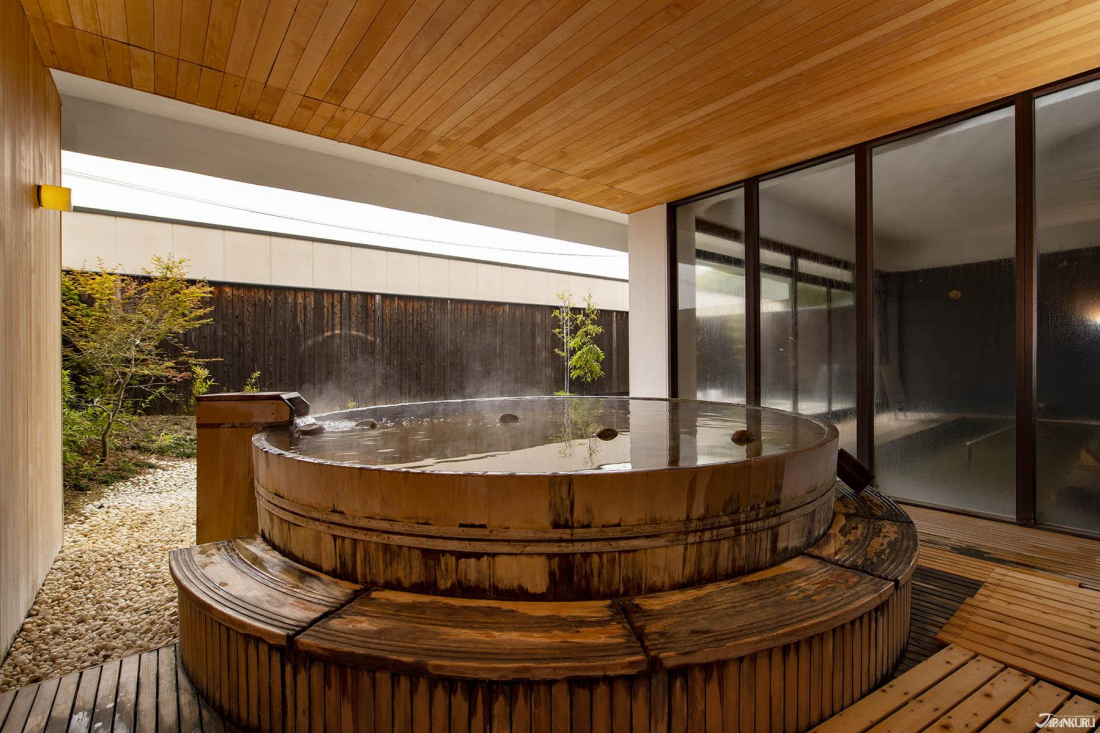
Hoshino Resorts KAI Enshu uses water from Kanzanji Onsen, itself the reason for many travelers’ visits, and for an extra-luxe experience you can even book a room with a private bath to soak in undisturbed. To add a unique touch to their communal bath area, they offer a green tea onsen. With actual tea leaves floating in bundles and imbuing the water with the essence of green tea, the smell and the antioxidants rejuvenating your skin make it a totally new way to enjoy Shizuoka tea.
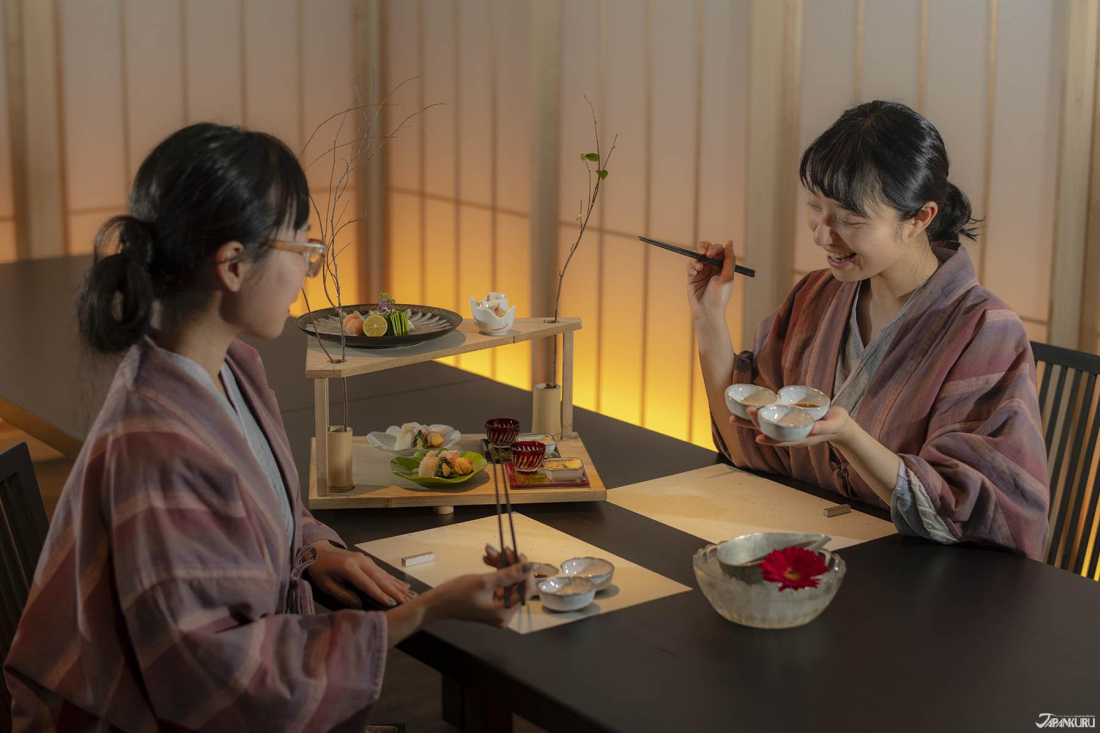
Of course, we’d already heard that the unagi (eel) and fugu (pufferfish) in Hamamatsu was some of the best in Japan, so the gourmet kitchens at KAI Enshu seemed like a fantastic place to try the gourmet ingredients. The resort offers a few different meal plans, including breakfasts served partially inside tea boxes, with the gentle fragrance of warmed tea leaves permeating and flavoring the food. We were also lucky enough to enjoy their kaiseki dinner, a multi-course meal of expertly prepared Japanese cuisine.

Seasonal ingredients are an important part of any good Japanese meal, so we were extremely pleased to hear that we were there at a great time to try fugu. In Japan, most people associate fugu with the city of Shimonoseki in Yamaguchi Prefecture, but we learned that experts actually rank the quality of fugu in Hamamatsu at least as highly. After trying the delicate, transparent slices of pufferfish, we had no reason to doubt that ranking.
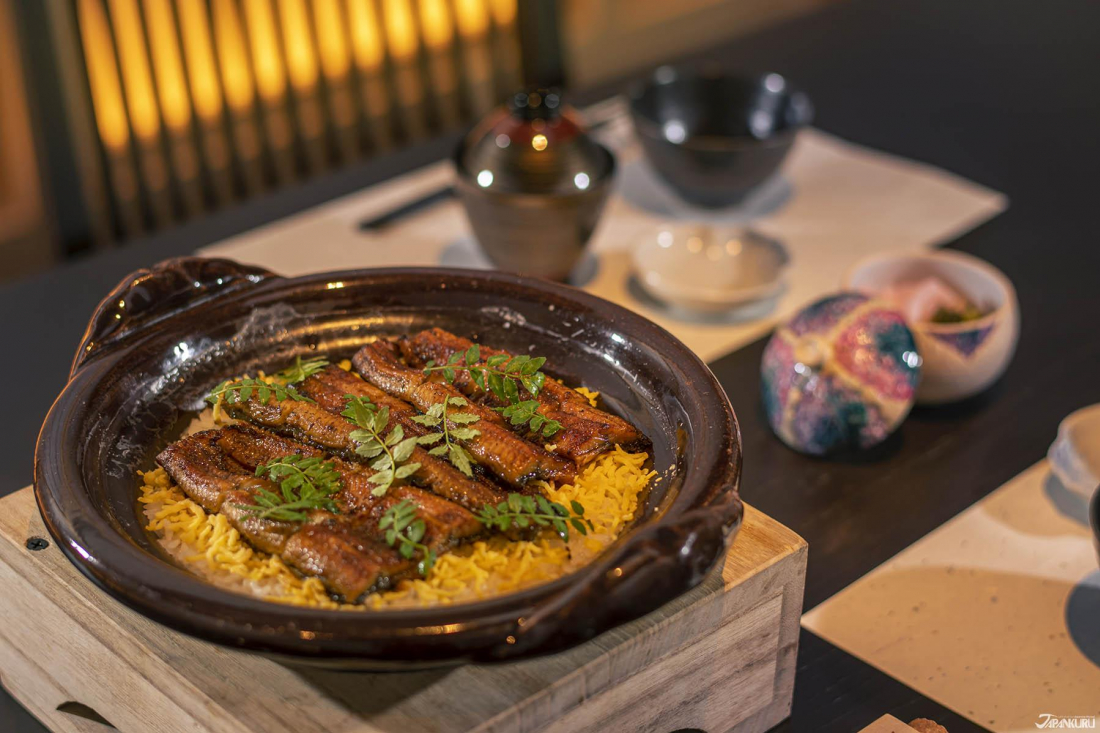
Of course, there’s no doubting that Hamamatsu is an excellent place to try Japanese unagi. The kaiseki meal came with not one or two, but three different dishes focusing on the local delicacy, each complementing the eel’s flavor in an entirely different way.
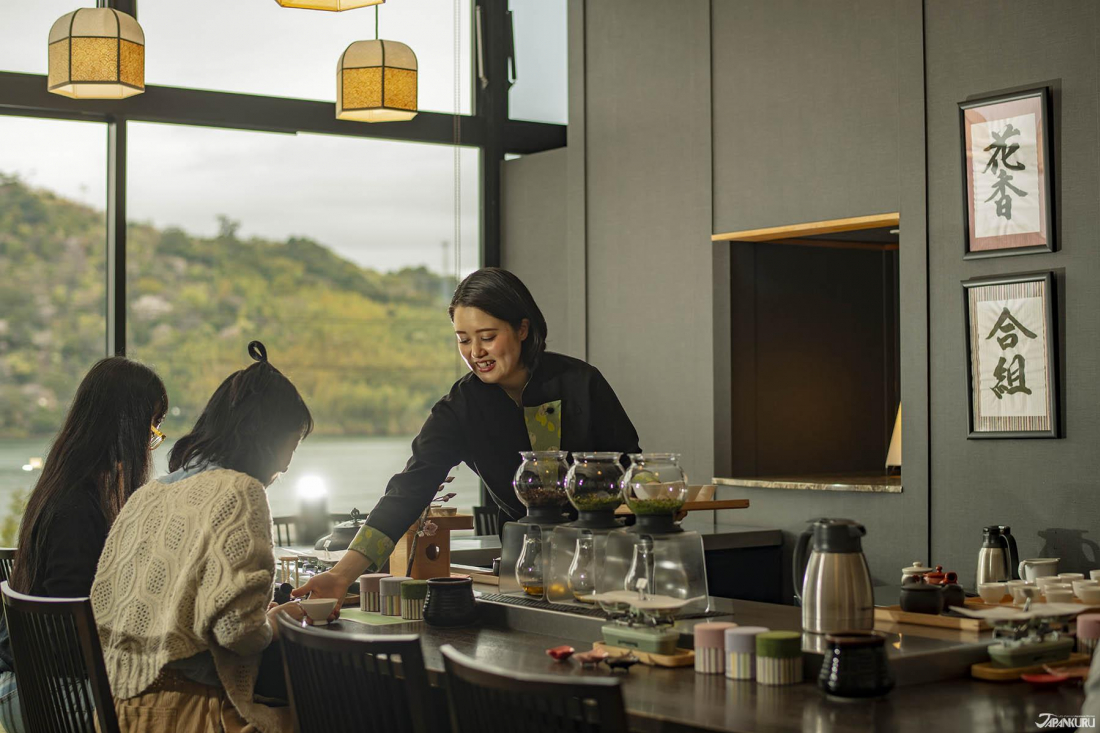
The luscious teas we drank with dinner were just the beginning for KAI Enshu, a tea-themed resort. A tea room with snacks self-serve brewing stations featuring a dozen different tea varieties, the aroma of tea ceremony permeating the air, tea experts on staff, and seasonal tea experiences – it was heaven for the tea lovers on the Japankuru team. We heard about different workshops at other times of year (like roasting hojicha!), but during our springtime visit we got the chance to sample and create our own tea blend with advice and guidance from a staff member with extraordinarily deep knowledge on the subject.

We finished the experience with one last taste of spring, a cup of cherry blossom tea…

…and made the most of the lovely weather with morning stretches in the hotel’s small tea field.
Hoshino Resorts KAI Enshu (星野リゾート 界 遠州)
399-1 Kanzanjicho, Nishi Ward, Hamamatsu, Shizuoka
Official Website (en)
Lake Hamana Flower Festival
Japan loves its seasonal culture, and that’s not just limited to seasonal cuisine like fugu and unagi. Throughout the spring and summer, countless varieties of flower bloom throughout Japan and become colorful attractions in and of themselves, with parks and botanical gardens drawing travelers from around the country – and the world. Outside of Japan, the country’s springtime cherry blossoms are most well-known, but the Hamamatsu City’s yearly Lake Hamana Flower Festival (浜名湖花フェスタ) celebrates those and much more. We headed to Hamamatsu Flower Park to see as many flowers as we could!

Waves of tulips with petals in every color of the rainbow covered the ground, and sprays of cherry blossom hung down around the grassy areas. This unusual floral combination is part of what makes Hamamatsu Flower Park so popular! With people so concentrated on the cherry blossoms alone, Hamamatsu Flower Park offers a rare chance to appreciate the lovely contrast of the pale blossoms and the vibrant colors of the tulips.

The park is large enough to spend the day if you want, but compact enough that you can make a loop on foot fairly quickly if you just want to take a few quick pictures. Of course our visit in early spring meant lots of tulips and tunnels of cherry blossoms, but each season brings different flowers to life at Hamamatsu Flower Park, like fall-blooming chrysanthemums.
For the ultimate in relaxed flower viewing, you can take a short funicular ride down a steep incline along the way, or even hop on the little “trains” that wind their way through the park.


“Nemophila,” also sometimes called “baby blue eyes,” aren’t a particularly iconic flower for most of the world, but in Japan people love to go see late-spring nemophila covering the hillsides with baby blue petals.
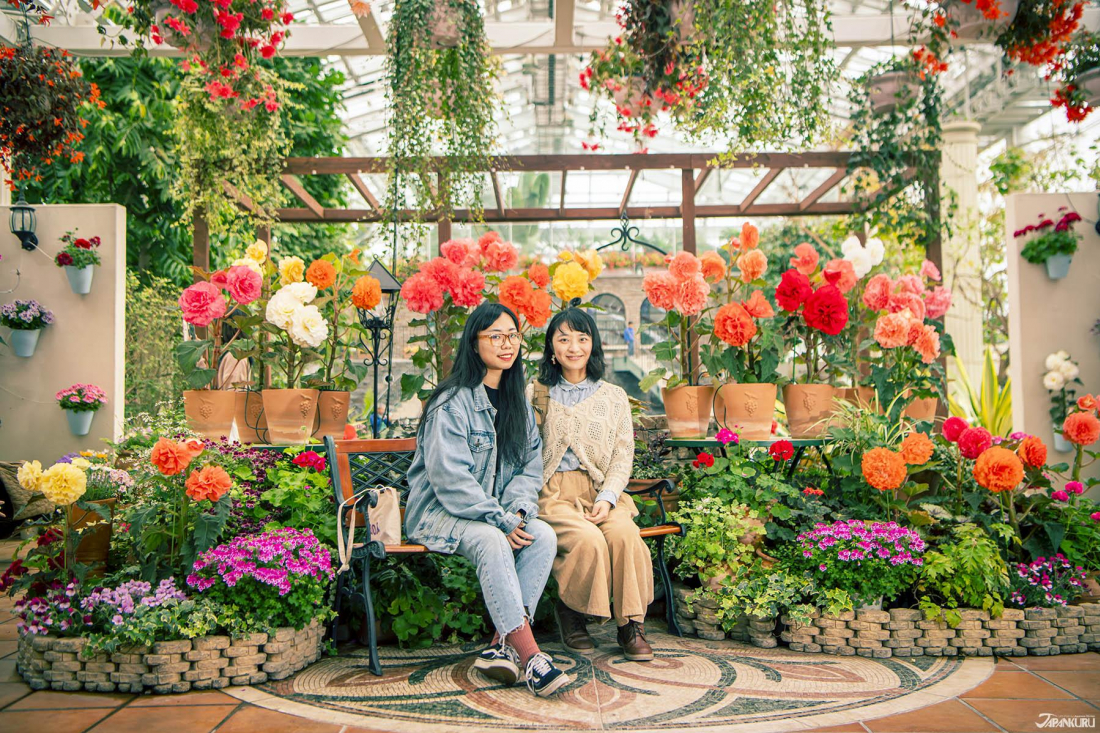
Even on a rainy day, the bright colors of the flowers inside the “Crystal Palace” (クリスタルパレス) greenhouse make it a cheery place to spend the afternoon.

The greenhouse is home to plants from all over the world, including black irises, donated by the Jordanian government! We spent hours admiring plants we’d never seen before within the Crystal Palace, and then taking a few too many pictures among the tulips and cherry blossoms outside.
Lake Hamana Flower Festival
mid-March to mid-June
Hamamatsu Flower Park
195 Kanzanjicho, Nishi Ward, Hamamatsu, Shizuoka
Hours:
・Mar to Sep: 09:00 – 17:00
・Oct to Nov: 09:00 – 16:30
・Dec to Feb: 10:00 -16:00
Admission:
・Mar to June: Adults 600~1,000 yen / Children & Seniors 300~500 yen
・July to Aug: Free!
・Sep to Feb: Adults 500 yen / Children & Seniors Free!
Official Website (jp)
More Unagi & Gyoza
Unagi at Kanzanjien
Visiting Hamamatsu, we couldn’t limit ourselves to just one meal of unagi! So we headed right to the source, and sat right over the water while we dug into rice bowls topped with the grilled eel. It’s Lake Hamanako’s brackish mix of fresh lake water and salty water from the Pacific Ocean that makes it such a good habitat for eel, so we gave our thanks to the lake as we enjoyed our meals.
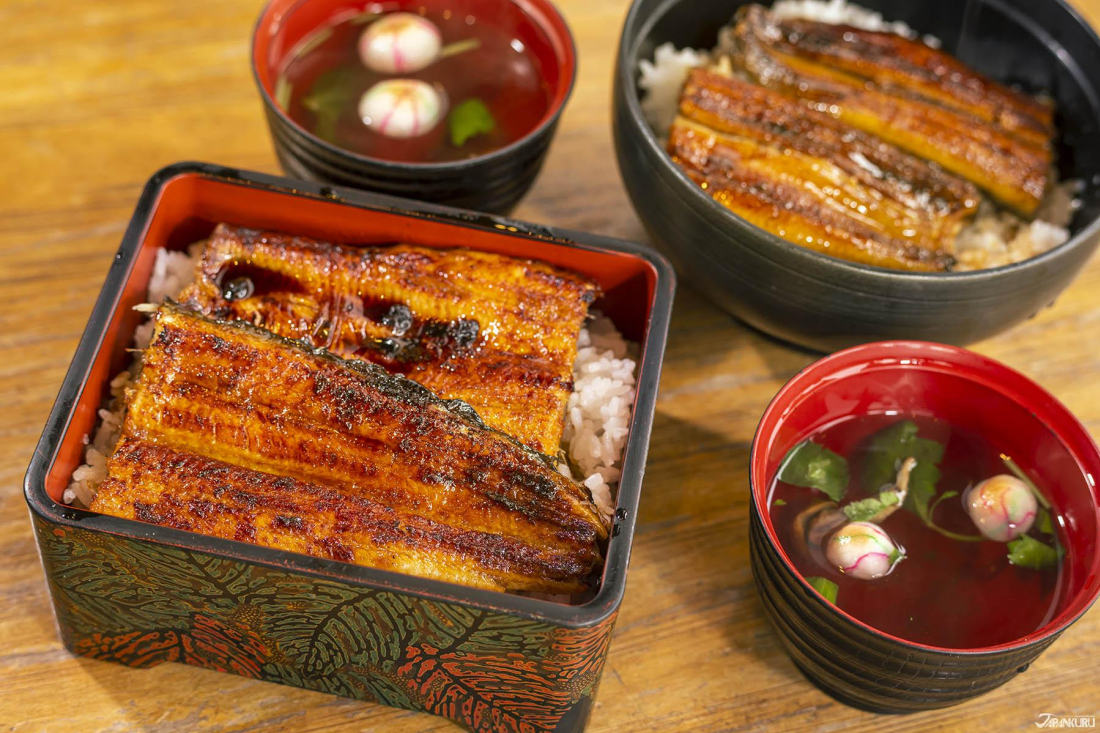
The skillfully grilled unagi was fragrant with the scents of charcoal and sweet eel sauce, and we could tell the eel itself was a cut above the rest as soon as we took one bite of the satisfyingly meaty fillets.
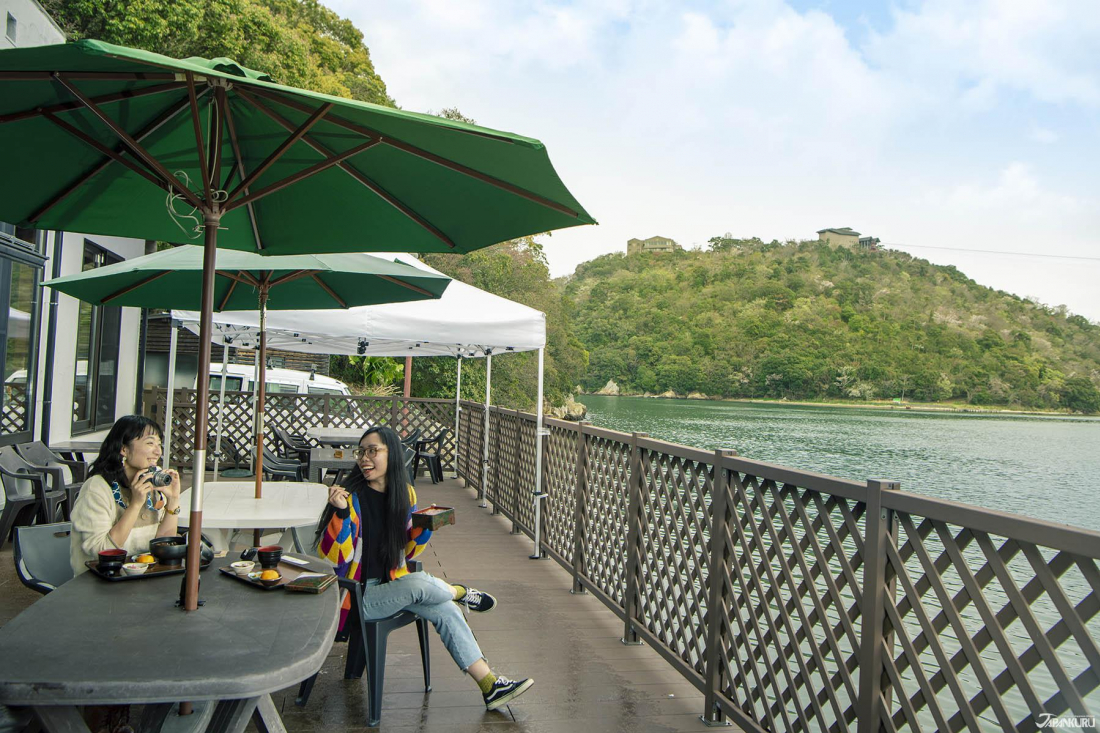
We ate on the lakeside terrace at Kanzanjien, a good option for travelers who want to try a taste of local unagi cuisine, but don’t want to go overboard with the lavish meals at KAI Enshu.
Kanzanjien (うなぎ湖畔食房 舘山寺園)
2229 Kanzanjicho, Nishi Ward, Hamamatsu, Shizuoka
Hours: 11:00 – 20:00 (last order)
Official Website (jp)
Hamamatsu Gyoza at Ishimatsu
Gyoza are ubiquitous in Japan, and the meaty little dumplings make a perfect snack with drinks or a full meal, but there are two cities especially famous for their gyoza. One is Utsunomiya in Tochigi, and the other is Hamamatsu, where they’ve been a staple for over 100 years.
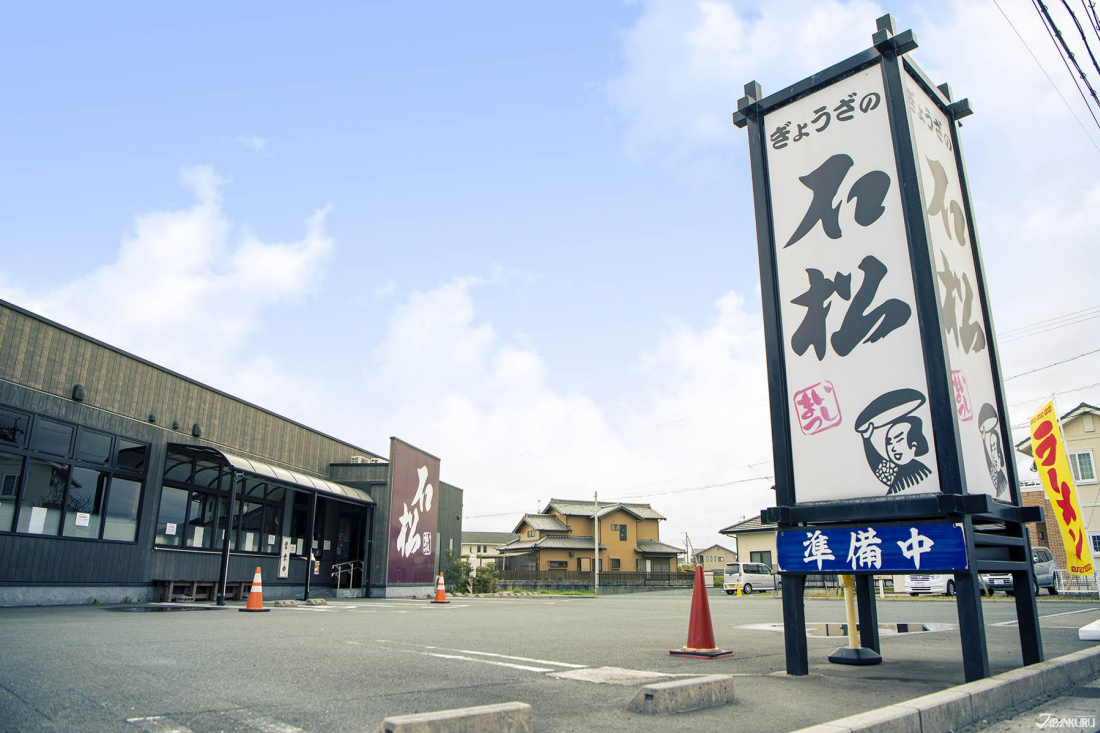
We headed to the flagship location of Ishimatsu Gyoza, a national chain that specializes in the local Hamamatsu dumplings.

While eating a previously unimaginable number of gyoza, we learned that there are three distinct characteristics that make Hamamatsu gyoza easily identifiable:
① The filling is just three simple ingredients – pork, cabbage, and onion!
② They’re fried in a ring, a reflection of the days when they were sold from small stalls and cooked using standard round frying pans.
③ They come with a side of bean sprouts, usually served right in the middle of the circle of gyoza. The bean sprouts act as a palate cleanser, making it easy to eat your way through dish after dish of the gyoza!
Ishimatsu Gyoza (石松餃子) Main Restaurant
252-1 Hirakuchi, Hamakita Ward, Hamamatsu, Shizuoka
Hours:
・Weekdays: 11:00 – 14:00, 17:00 – 20:00
・Weekends & Holidays: 11:00 – 20:00
Official Website (jp)
Unagi Pies from the Unagi Pie Factory
Already dreaming of all the food you’ll eat in Hamamatsu, but not sure what to bring home to your friends? The go-to souvenir is the Unagi Pie, a flaky, sweet pastry confection, similar in texture to French elephant ear cookies. Travelers can visit the Unagi Pie factory in Hamamatsu for a real look at the production line, along with a cafe, and a small museum space that offers some interesting Unagi Pie trivia.
The pie crust texture of the cookies is the obvious reason for the “pie” part of the name, but you might be just as surprised as we were to learn the reason why they’re literally called “eel pies.” You see, Unagi Pies actually have real eel extract added to the dough, deepening the flavor with an extra touch of umami! But it turns out that eel extract isn’t the only secret ingredient in the recipe, despite the undeniably sweet flavor of the snack, they actually contain garlic as well!
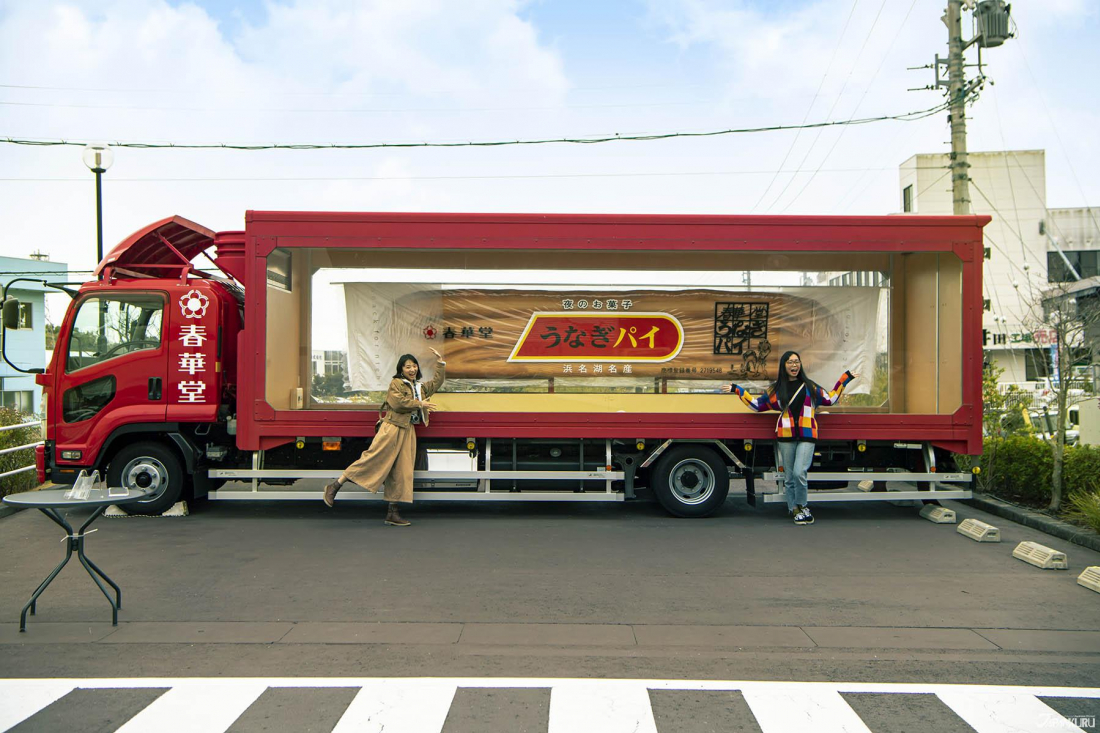
Right on the package you’ll see that Unagi Pie uses the slogan “Yoru no Okashi” (夜のお菓子) which they translate as “snack for night.” We headed over closer to lunchtime, though!
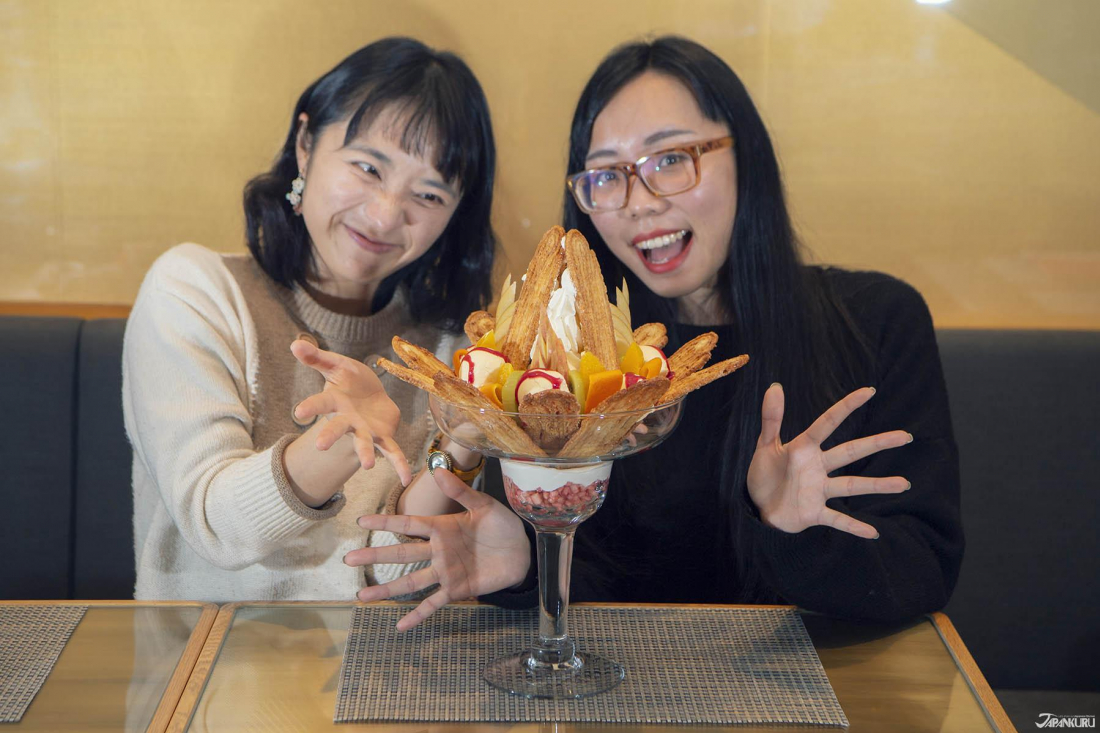
Not only is the factory free to enter, but we also got a little package of free samples! But with the sweet smells drifting off the factory floor, we wanted more. You too can order unique Unagi Pie creations at the factory cafe, like this over-the-top parfait.
Unagi Pie Factory (うなぎパイファクトリー)
748-51 Okubocho, Nishi Ward, Hamamatsu, Shizuoka
Hours: 9:30 – 17:30 (July/Aug ~18:00)
Factory Website (jp) / Unagi Pie Website (jp)
See You Again Soon, Hamamatsu!
Mount Fuji might be iconic, off in the distance, but after this trip the Japankuru team truly discovered how much more Shizuoka has to offer. Days spent gliding over Lake Hamanako, running through fields of tulips, and feasting on unagi, plus nights soaking in onsen baths and sipping fragrant green tea – if you’re looking for a destination that feels off-the-beaten-path but is really about as conveniently accessible as it gets, consider a trip to Hamamatsu City!
See more of our trip to Hamamatsu in our video below ⇩, and tell us what you think (or about your future plans to Shizuoka) on the Japankuru twitter, instagram, and facebook!
COMMENT
FEATURED MEDIA
VIEW MORE 
A New Tokyo Animal Destination: Relax & Learn About the World’s Animals in Japan
#pr #japankuru #anitouch #anitouchtokyodome #capybara #capybaracafe #animalcafe #tokyotrip #japantrip #카피바라 #애니터치 #아이와가볼만한곳 #도쿄여행 #가족여행 #東京旅遊 #東京親子景點 #日本動物互動體驗 #水豚泡澡 #東京巨蛋城 #เที่ยวญี่ปุ่น2025 #ที่เที่ยวครอบครัว #สวนสัตว์ในร่ม #TokyoDomeCity #anitouchtokyodome

Shohei Ohtani Collab Developed Products & Other Japanese Drugstore Recommendations From Kowa
#pr #japankuru
#kowa #syncronkowa #japanshopping #preworkout #postworkout #tokyoshopping #japantrip #일본쇼핑 #일본이온음료 #오타니 #오타니쇼헤이 #코와 #興和 #日本必買 #日本旅遊 #運動補充能量 #運動飲品 #ช้อปปิ้งญี่ปุ่น #เครื่องดื่มออกกำลังกาย #นักกีฬา #ผลิตภัณฑ์ญี่ปุ่น #อาหารเสริมญี่ปุ่น

도쿄 근교 당일치기 여행 추천! 작은 에도라 불리는 ‘가와고에’
세이부 ‘가와고에 패스(디지털)’ 하나면 편리하게 이동 + 가성비까지 완벽하게! 필름카메라 감성 가득한 레트로 거리 길거리 먹방부터 귀여움 끝판왕 핫플&포토 스폿까지 총집합!
Looking for day trips from Tokyo? Try Kawagoe, AKA Little Edo!
Use the SEIBU KAWAGOE PASS (Digital) for easy, affordable transportation!
Check out the historic streets of Kawagoe for some great street food and plenty of picturesque retro photo ops.
#pr #japankuru #도쿄근교여행 #가와고에 #가와고에패스 #세이부패스 #기모노체험 #가와고에여행 #도쿄여행코스 #도쿄근교당일치기 #세이부가와고에패스
#tokyotrip #kawagoe #tokyodaytrip #seibukawagoepass #kimono #japantrip

Hirakata Park, Osaka: Enjoy the Classic Japanese Theme Park Experience!
#pr #japankuru #hirakatapark #amusementpark #japantrip #osakatrip #familytrip #rollercoaster #retrôvibes #枚方公園 #大阪旅遊 #關西私房景點 #日本親子旅行 #日本遊樂園 #木造雲霄飛車 #히라카타파크 #สวนสนุกฮิราคาตะพาร์ค

🍵Love Matcha? Upgrade Your Matcha Experience With Tsujiri!
・160년 전통 일본 말차 브랜드 츠지리에서 말차 덕후들이 픽한 인기템만 골라봤어요
・抹茶控的天堂!甜點、餅乾、飲品一次滿足,連伴手禮都幫你列好清單了
・ส่องมัทฉะสุดฮิต พร้อมพาเที่ยวร้านดังในอุจิ เกียวโต
#pr #japankuru #matcha #matchalover #uji #kyoto #japantrip #ujimatcha #matchalatte #matchasweets #tsujiri #말차 #말차덕후 #츠지리 #교토여행 #말차라떼 #辻利抹茶 #抹茶控 #日本抹茶 #宇治 #宇治抹茶 #日本伴手禮 #抹茶拿鐵 #抹茶甜點 #มัทฉะ #ของฝากญี่ปุ่น #ชาเขียวญี่ปุ่น #ซึจิริ #เกียวโต

・What Is Nenaito? And How Does This Sleep Care Supplement Work?
・你的睡眠保健品——認識「睡眠茶氨酸錠」
・수면 케어 서플리먼트 ‘네나이토’란?
・ผลิตภัณฑ์เสริมอาหารดูแลการนอน “Nenaito(ネナイト)” คืออะไร?
#pr #japankuru #sleepcare #japanshopping #nenaito #sleepsupplement #asahi #睡眠茶氨酸錠 #睡眠保健 #朝日 #l茶胺酸 #日本藥妝 #日本必買 #일본쇼핑 #수면 #건강하자 #네나이토 #일본영양제 #อาหารเสริมญี่ปุ่น #ช้อปปิ้งญี่ปุ่น #ร้านขายยาญี่ปุ่น #ดูแลตัวเองก่อนนอน #อาซาฮิ

Japanese Drugstore Must-Buys! Essential Items from Hisamitsu® Pharmaceutical
#PR #japankuru #hisamitsu #salonpas #feitas #hisamitsupharmaceutical #japanshopping #tokyoshopping #traveltips #japanhaul #japantrip #japantravel

Whether you grew up with Dragon Ball or you just fell in love with Dragon Ball DAIMA, you'll like the newest JINS collab. Shop this limited-edition Dragon Ball accessory collection to find some of the best Dragon Ball merchandise in Japan!
>> Find out more at Japankuru.com! (link in bio)
#japankuru #dragonball #dragonballdaima #animecollab #japanshopping #jins #japaneseglasses #japantravel #animemerch #pr

This month, Japankuru teamed up with @official_korekoko to invite three influencers (originally from Thailand, China, and Taiwan) on a trip to Yokohama. Check out the article (in Chinese) on Japankuru.com for all of their travel tips and photography hints - and look forward to more cool collaborations coming soon!
【橫濱夜散策 x 教你怎麼拍出網美照 📸✨】
每次來日本玩,是不是都會先找旅日網紅的推薦清單?
這次,我們邀請擁有日本豐富旅遊經驗的🇹🇭泰國、🇨🇳中國、🇹🇼台灣網紅,帶你走進夜晚的橫濱!從玩樂路線到拍照技巧,教你怎麼拍出最美的夜景照。那些熟悉的景點,換個視角說不定會有新發現~快跟他們一起出發吧!
#japankuru #橫濱紅磚倉庫 #汽車道 #中華街 #yokohama #japankuru #橫濱紅磚倉庫 #汽車道 #中華街 #yokohama #yokohamaredbrickwarehouse #yokohamachinatown

If you’re a fan of Vivienne Westwood's Japanese designs, and you’re looking forward to shopping in Harajuku this summer, we’ve got important news for you. Vivienne Westwood RED LABEL Laforet Harajuku is now closed for renovations - but the grand reopening is scheduled for July!
>> Find out more at Japankuru.com! (link in bio)
#japankuru #viviennewestwood #harajuku #omotesando #viviennewestwoodredlabel #viviennewestwoodjapan #비비안웨스트우드 #오모테산도 #하라주쿠 #日本購物 #薇薇安魏斯伍德 #日本時尚 #原宿 #表參道 #japantrip #japanshopping #pr

Ready to see TeamLab in Kyoto!? At TeamLab Biovortex Kyoto, the collective is taking their acclaimed immersive art and bringing it to Japan's ancient capital. We can't wait to see it for ourselves this autumn!
>> Find out more at Japankuru.com! (link in bio)
#japankuru #teamlab #teamlabbiovortex #kyoto #kyototrip #japantravel #artnews
Photos courtesy of teamLab, Exhibition view of teamLab Biovortex Kyoto, 2025, Kyoto ® teamLab, courtesy Pace Gallery

Japanese Makeup Shopping • A Trip to Kamakura & Enoshima With Canmake’s Cool-Toned Summer Makeup
#pr #canmake #enoshima #enoden #에노시마 #캔메이크 #japanesemakeup #japanesecosmetics

⚔️The Robot Restaurant is gone, but the Samurai Restaurant is here to take its place. Check it out, and don't forget your coupon!
🍣신주쿠의 명소 로봇 레스토랑이 사무라이 레스토랑으로 부활! 절찬 쿠폰 발급중
💃18歲以上才能入場的歌舞秀,和你想的不一樣!拿好優惠券去看看~
#tokyo #shinjuku #samurairestaurant #robotrestaurant #tokyotrip #도쿄여행 #신주쿠 #사무라이레스토랑 #이색체험 #할인이벤트 #歌舞伎町 #東京景點 #武士餐廳 #日本表演 #日本文化體驗 #japankuru #japantrip #japantravel #japanlovers #japan_of_insta

Japanese appliance & electronics shopping with our KOJIMA x BicCamera coupon!
用JAPANKURU的KOJIMA x BicCamera優惠券買這些正好❤️
코지마 x 빅 카메라 쿠폰으로 일본 가전 제품 쇼핑하기
#pr #japankuru #japanshopping #kojima #biccamera #japaneseskincare #yaman #dji #osmopocket3 #skincaredevice #日本購物 #美容儀 #相機 #雅萌 #日本家電 #일본여행 #면세 #여행꿀팁 #일본쇼핑리스트 #쿠폰 #일본쇼핑 #일본브랜드 #할인 #코지마 #빅카메라 #japankurucoupon











































